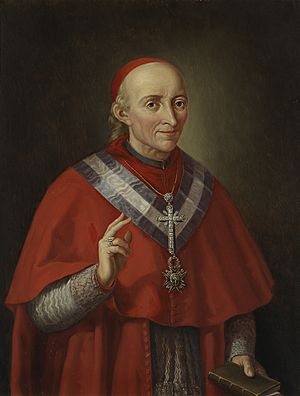Francisco Antonio de Lorenzana facts for kids
Quick facts for kids
Francisco Antonio de Lorenzana y Butrón
|
|
|---|---|
 |
|
| Archbishop of Mexico | |
| In office 1766–1772 |
|
| Monarch | Ferdinand VI |
| Preceded by | Manuel José Rubio y Salinas |
| Succeeded by | Alonso Núñez de Haro y Peralta |
| Grand Inquisitor of Spain | |
| In office 1794–1797 |
|
| Preceded by | Manuel Abad y Lasierra |
| Succeeded by | Ramón José de Arce |
| Personal details | |
| Born | 22 September 1722 Leon, Spain |
| Died | April 17, 1804 (aged 81) Rome, Italy |
Francisco Antonio de Lorenzana y Butrón (born September 22, 1722 – died April 17, 1804) was an important leader in the Catholic Church. He became a Cardinal and also served as the Archbishop of Mexico.
Contents
Life and Work
Early Life and Church Career
Francisco Lorenzana studied at a Jesuit school in his hometown. He then joined the church and quickly became a canon in Toledo, Spain. In 1765, he was made the Bishop of Plasencia.
The next year, he was given the big job of leading the Archdiocese of Mexico. While in Mexico, he started a home for children who had been abandoned. He paid for this home himself. He also gathered and published important church documents from Mexico's past. These documents were from church meetings held in 1555, 1565, and 1585.
In 1771, he organized another important church meeting in Mexico. He also collected valuable historical papers about Mexico's history. He published these in a book called Historia de Nueva Espana (History of New Spain) in 1770.
Archbishop of Toledo
In 1772, Lorenzana was called back to Spain. He was put in charge of the Archdiocese of Toledo, which was a very important position. He built a library for Toledo and collected the writings of important church leaders from the city. These works were published in a collection called SS. Patrum Toletanorum opera.
He also published new versions of old church books, like the Breviarium Gothicum and the Missale Gothicum. These books were used in a special old church service called the Mozarabic Rite. He also helped publish the works of Isidore of Seville, another important Spanish church figure.
Helping People in Toledo
Besides his scholarly work, Lorenzana was very active in helping people. He started hospitals and homes for those in need. He turned an old castle into a workhouse, which was a place where poor people could work. He also supported the silk industry and taught local priests how to help farmers improve their crops. Lorenzana believed it was important to improve people's lives on Earth, not just focus on life after death.
During the French Revolution, many French priests had to leave their country. Lorenzana was very kind to them, taking in over 500 of these exiled priests into his own church area.
Becoming a Cardinal
In 1789, Pope Pius VI made him a Cardinal. From 1794 to 1797, he served as the Grand Inquisitor of Spain. In 1797, he became Spain's special representative to the Holy See (the Pope's government). In this role, he supported the Pope during difficult times when France invaded.
When Pope Pius VI died, Lorenzana helped make sure a new Pope could be chosen. He paid for some cardinals who had no money to travel to the meeting in Venice in 1799. He then went with the new Pope, Pius VII, to Rome. To stay by the Pope's side, he gave up his position as Archbishop in 1800.
In Rome, he continued to be active. In 1801, he helped start a new Catholic Academy. He also received a large inheritance of 25,000 scudi (an old type of money). He gave all of this money to the poor, saying they were his true heirs.
Lorenzana was an important person in Mexican history because he collected and edited many old documents. He helped publish the works of writers like Juan López de Velasco and Juan Suárez de Peralta. He also published letters from the famous explorer Hernán Cortés, which included stories about Cortés's trips to Baja California.
After King Charles III died in 1788, his son King Charles IV replaced Cardinal Lorenzana with another church leader, Luis de Borbón.
| Catholic Church titles | ||
|---|---|---|
| Preceded by Manuel José Rubio y Salinas |
Archbishop of Mexico 1766 – 1772 |
Succeeded by Alonso Núñez de Haro y Peralta |
| Preceded by Manuel Abad y Lasierra |
Grand Inquisitor of Spain 1794–1797 |
Succeeded by Ramón José de Arce |
See also
 In Spanish: Francisco de Lorenzana para niños
In Spanish: Francisco de Lorenzana para niños

